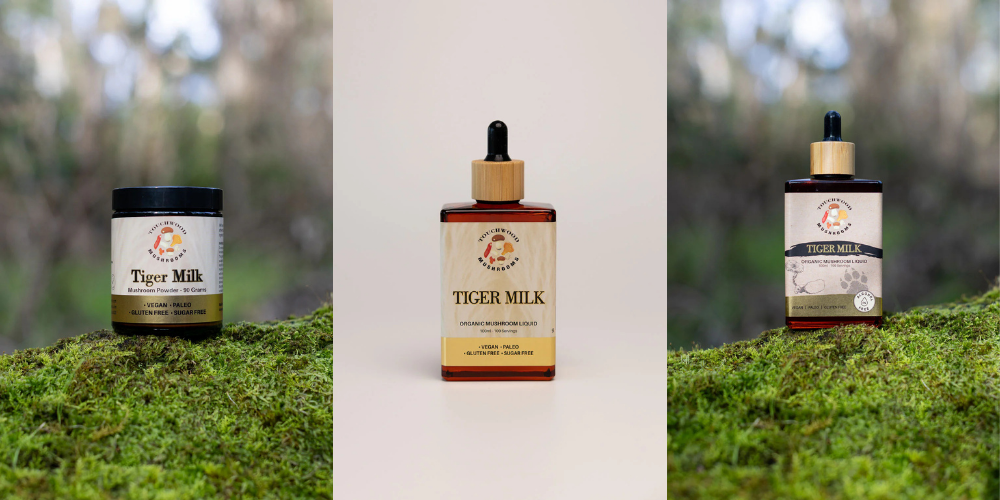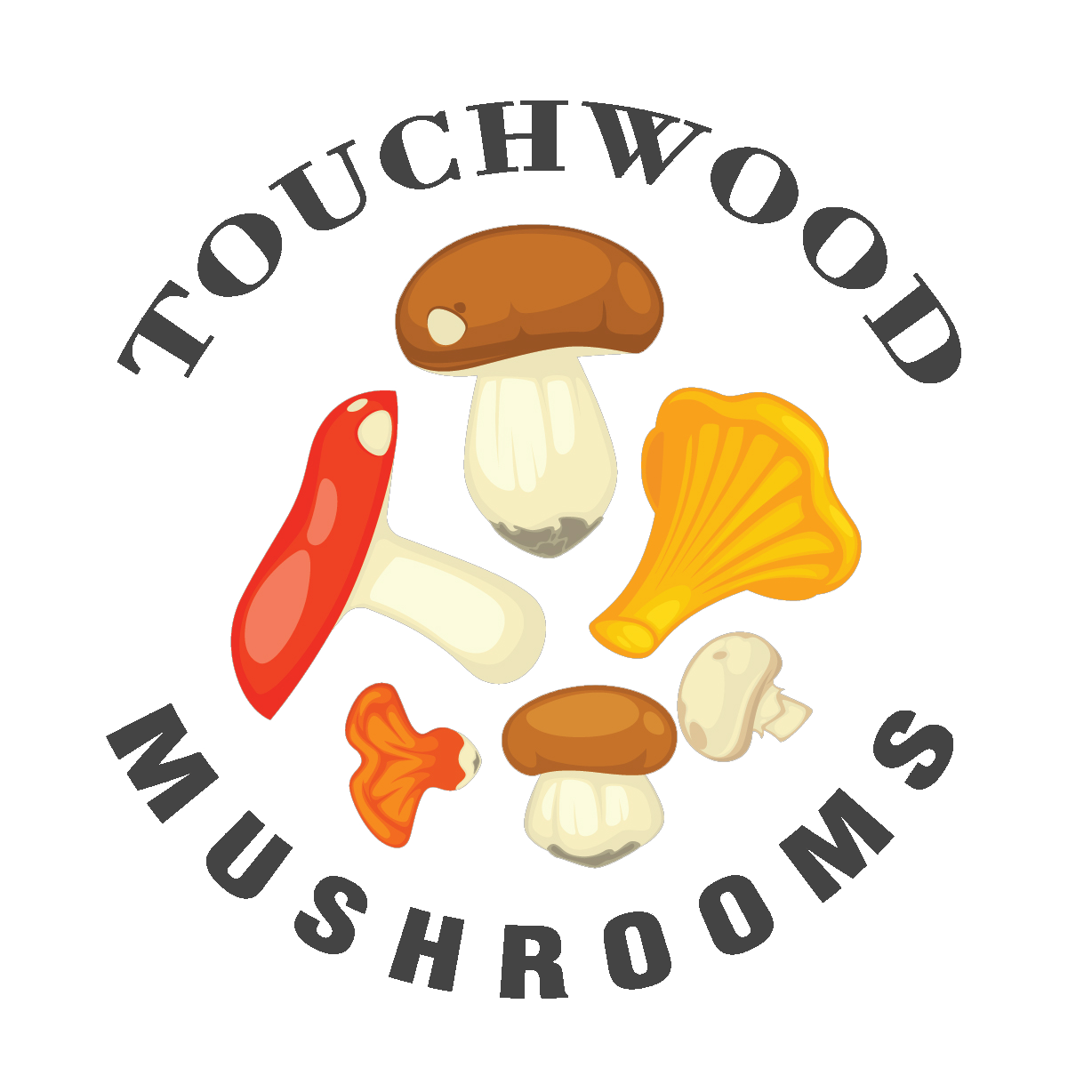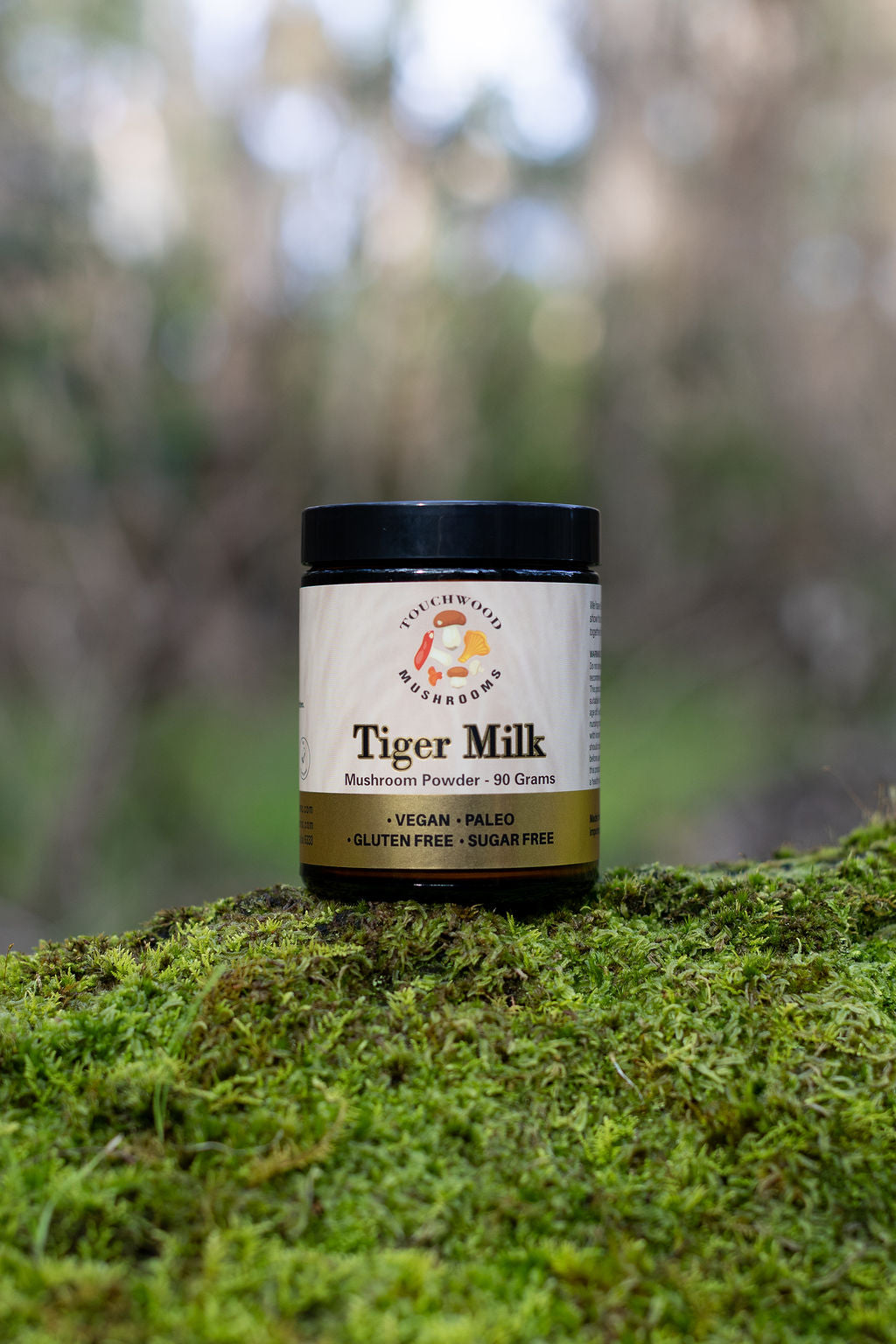
Given that functional mushrooms have a history that stretches back thousands of years, it's not all that often that we get to announce a new product. And yet there is a new functional mushroom available with an incredible range of potential benefits that we believe will become increasingly popular.
Known scientifically as Lignosus rhinocerus, but more commonly as "Tiger Milk mushroom" or "Cendawan Susu Rimau," this fungus has earned near-mythical status.
The name itself tells a story – folklore suggests these mushrooms grow from the soil where tigers have spilled milk while nursing their cubs. While just a legend, it speaks to both the mushroom's scarcity and its milky-white appearance.
So what makes this particular mushroom worth looking into? Deep in the tropical forests of Southeast Asia grows a rare treasure that traditional healers have sought out for generations. What truly sets Tiger Milk mushroom apart is its remarkable affinity for respiratory health. While many functional mushrooms offer potential for immune support, Tiger Milk demonstrates specific benefits for breathing comfort, lung function and respiratory wellness – benefits now being validated by modern research.
We're proud to bring Tiger Milk mushroom to the Australian market, developing a potent supplement in both powder and liquid form.
In this guide, we'll explore where Tiger Milk mushroom comes from, the science behind it and share practical advice on incorporating this exceptional fungus into your routine.
- What’s special about Tiger Milk mushrooms
- Tiger Milk in traditional medicine
- Modern cultivation makes it possible
- Health benefits of Tiger Milk mushrooms
- How to choose a quality Tiger Milk mushroom supplement
- How to take Tiger Milk mushroom supplement
- Frequently Asked Questions
What’s special about Tiger Milk mushrooms
Tiger Milk mushrooms are a rare fungus native to tropical forests of Southeast Asia. In Malaysia and Indonesia the mushroom is known as “cendawan susu rimau”. This originates from the belief the mushroom grew from small drops of milk dropped by lactating tigers as they roamed the forest floor.
Unlike mushrooms that grow in clusters, Tiger Milk mushrooms grow in isolation, often kilometres apart, making them exceptionally difficult to find.
Tiger Milk mushroom is made up of three parts: the pileus (cap), stipe (stem) and sclerotium (tuber). While typical polypores grow on a woody substrate like a tree or log, the fruiting body of Tiger Milk mushrooms emerge from the underground tuber (sclerotium). This is a compact mass of fungal mycelium that stores food reserves.
Tiger Milk in traditional medicine
Tiger Milk mushroom may be new to the functional mushroom world, but it has a history in traditional medicine that stretches back hundreds of years. The earliest written record of Tiger Milk mushroom is from 1664 when a navigator called John Evelyn noted in his diary that specimens were presented to the Paris collection.
Traditional use of Tiger Milk mushroom has been documented across Malaysia, China and Thailand [1]. Different indigenous groups have their own methods of processing and ingesting Tiger Milk mushroom, but it often involves crushing, grinding or slicing the mushroom then mixing with hot or cold water to make a tonic. This would then be drunk to alleviate chronic cough, sore throat, allergies, fever and sinus issues as well as joint pain, food poisoning and other illnesses [2].
At other times, whole Tiger Milk mushroom would be carried by people as they travelled through the jungle, who would then nibble on the mushroom to gain strength and energy.
Because of its rarity in nature, very little was known about Tiger Milk mushroom outside of these communities until the 2010s.
Modern cultivation makes it possible
In 2002, then Prime Minister of Malaysia Dr Mahathir Bin Mohamed mentioned during his keyword address at the International Biotechnology Convention in Kuala Lumpur that he had used Tiger Milk mushroom to treat the chronic cough he had experienced for much of his life.
Sitting in the audience was Dr Tan Chon Seng, a researcher with Malaysia Agricultural Research & Development Institute (MARDI). Intrigued, he began researching Tiger Milk mushroom, eventually working with a team of scientists to develop the cultivation technology needed to produce reliably potent, sustainably-grown Tiger Milk mushroom.
This means finally Tiger Milk mushroom could be cultivated for commercial use as well as increasing research on the health benefits of these mushrooms.
What the science says about Tiger Milk mushrooms
After five decades working with medicinal mushrooms, we've seen firsthand how nature packs powerful compounds into these extraordinary fungi. Tiger Milk Mushroom is no exception – this Southeast Asian treasure contains a remarkable array of bioactive components that explain its traditional uses and emerging scientific interest.
Beta-Glucans
These natural polysaccharides are a focus of scientific research due to their potential health benefits.
What makes Tiger Milk Mushroom special? One study has shown that beta-glucans make up between 82-93% of all glucans in water extracts of this mushroom – an exceptionally high concentration that contributes to its potency [3].
These beta-glucans aren't just any compounds – they're recognised by scientists as Biological Response Modifiers (BRMs). This means they help the immune system work smarter, not harder, adjusting its activity based on what your body needs.
The beta-D glucans specific to Tiger Milk Mushroom have demonstrated significant antioxidant properties in laboratory studies, helping to explain its traditional reputation for supporting overall wellness and vitality [4].
Fungal Immune-Modulatory Proteins (FIPs)
Tiger Milk Mushroom contains specialised proteins called FIPs (Fungal Immune-Modulatory Proteins) that fine-tune immune responses. Laboratory research has shown these proteins to have “strong dose dependent antitumor effect” [5].
In plain language, these proteins appear to help slow down or prevent the multiplication of these problematic cells, though we emphasise that much more clinical research is needed before making any definitive claims in this area.
Lectins
Lectins make up nearly 40% of its protein profile – an impressively high amount.
What are lectins? They're specialised proteins that bind to specific carbohydrates, acting as communication molecules between cells. The lectins in Tiger Milk Mushroom demonstrate similar immune-modulating properties to FIPs, contributing to its overall beneficial effects [6].
This high lectin content helps distinguish Tiger Milk Mushroom from other functional mushrooms and may partially explain its unique affinity for respiratory support in traditional use.
Antioxidant Proteins
A research study found three major antioxidant proteins that form a defense system against oxidative stress in Tiger Milk Mushroom: Manganese Superoxide Dismutase (Mn-SOD), Catalases (CAT) enzymes and Glutathione S-transferase (GST) protein. This antioxidant defense system likely contributes to the mushroom's properties by neutralising harmful free radicals, protecting against oxidative stress and supporting cellular health and longevity [7].

Health benefits of Tiger Milk mushrooms
With Tiger Milk mushroom now being successfully cultivated in the lab, research into the therapeutic benefits has increased significantly. While study of this mushroom is relatively new, compared to other functional mushroom species, the studies show promising outcomes for a range of health benefits.
Potential benefits for respiratory support
Emerging research appears to support the traditional uses of Tiger Milk mushroom for respiratory support, including in the areas of:
Asthma Management
Research shows Tiger Milk extracts significantly reduce immunoglobulin E (IgE) levels and inflammatory T-helper type 2 cytokines in laboratory studies [8]. In practical terms, this means Tiger Milk helps modulate overactive immune responses that trigger asthma symptoms and airway inflammation – addressing the root cause rather than just masking symptoms.
Measurable Lung Function Improvement
A clinical study revealed that daily Tiger Milk supplementation over three months increased the FEV1/FVC ratio (a key measure of lung function) by 27.2% [9]. This translates to noticeably improved breathing capacity and airflow.
Reduced Respiratory Symptoms
The same study documented a remarkable 74.1% reduction in nasal symptoms and 73.2% decrease in overall respiratory discomfort using standardised assessment scales [9]. This aligns perfectly with the traditional uses we've documented throughout Southeast Asia.
Additional potential benefits
While respiratory support remains Tiger Milk's standout quality, research suggests several additional health-promoting properties:
Cardiovascular Support
Studies have identified natural clot-dissolving enzymes in Tiger Milk that help break down fibrin (the protein that binds clots together) [10, 11]. It also demonstrates anti-platelet activity, potentially supporting healthy circulation [12].
Balanced Inflammatory Response
Tiger Milk helps modulate TNF-α production – a key driver of inflammation when overexpressed [13, 14]. The alcohol extract specifically reduces inflammatory nitric oxide production through the STAT3 pathway [15, 16], while compounds like linoleic acid target inflammatory enzymes [17].
Tiger milk mushroom can also help to relieve joint pain and help support the body in healing inflammation. This helps to relieve unwanted aches and pains.
Immune System Balance
Tiger Milk demonstrates immunomodulatory properties – helping regulate immune responses for optimal function [18, 19]. This balanced approach makes it particularly valuable for long-term wellness support.
Lignosus rhinocerus has been shown to be effective in reducing the body’s reaction to allergens due to its high anti-inflammatory properties. This helps to relieve respiratory symptoms such as asthma, sinusitis, allergic rhinitis, and coughing. It is also seen to be beneficial to people who are exposed to polluted environments or are heavy smokers.
It has the ability to harmonize several cytokines and important anti-inflammatory properties in the body. Cytokines are small proteins that are essential in controlling the activity and growth of other immune system cells and blood cells. When released, they signal the immune system to do its job.
Cognitive Function
Several studies have shown Tiger Milk extracts promote neurite growth – essential for nerve signal transmission [20]. When combined with nerve growth factor (NGF), it enhances this effect further, suggesting potential benefits for cognitive function and neurological health.
How to choose a quality Tiger Milk mushroom supplement
With so many options available – from liquid and powder extract, to teas and freeze dried powder – there are a few considerations when it comes to choosing a Tiger Milk mushroom supplement.
Freeze dried powder vs extract
Traditionally, Tiger Milk mushroom would be consumed whole, or dried and ground into a powder to be and mixed with hot or cold water. While these methods certainly offered some benefits, with modern science we know that dual-extraction is the preferred process to draw out the highest levels of beneficial compounds from functional mushrooms.
Dual-extraction process
We’ve perfected our dual-extraction process over decades to maximise Tiger Milk’s bioactive compounds.
Dual-extraction releases the water-soluble compounds, including essential beta glucans, and the fat-soluble compounds, such as hericenones.
This is the difference between Touchwood Mushrooms products and other suppliers who may process freeze-dried mushrooms, which in our experience doesn’t unlock all the benefits.
100% Fruit Body
Unlike other edible mushrooms known where you consume the top part of the mushroom, the most potent part of the Tiger Milk mushroom is the sclerotia, which is the tuber-like base that traditionally grows underground.
There are four main stages to Tiger Milk cultivation. First, carefully selected spores are cultured on an agar medium to develop a mycelium. This mycelium is then colonised on a nutrient-rich medium to form the “spawn”. When the mycelium is mature it is then transferred to a soil-like medium where the sclerotia will grow and form until it is ready to be harvested. This whole process can take up to a year.
It’s important that only the fruit body (in this case, the sclerotia) is used in the extraction process, after separating it from the mycelium. In our experience, there is little to no functional benefit derived from including the mycelium or any substrate in the final extract. That’s why you should look for products that use only 100% fruit body mushroom in the extraction process.
Where is Tiger Milk mushroom grown?
Due to the difficulty in cultivating Tiger Milk mushrooms, there are only a few facilities that have developed the technology to consistently and sustainably grow high-potency mushrooms. We’re proud to have partnered with organically certified, dedicated facilities in southern China (where the hot and humid climate suits these mushrooms) to source our premium mushrooms. All of our imported products are triple checked by the FDA and Australian customs.
How to take Tiger Milk mushroom supplement
Tiger Milk mushroom extract can be taken at any time of the day, depending on what your wellness goals are. Some people choose to take it in the morning to support respiratory and immune function throughout the day, while others take it as part of their evening routine for breathing comfort during sleep. Some people even split their daily serving, taking half in the morning and half in the evening.
You’ll find increased benefits with consistent use, so it’s important to find a way to incorporate it
Tiger Milk Mushroom Powder suggested serving:
Add a half a level teaspoon to your favourite hot drink, soup or stew. The powder form dissolves quickly and has a very mild flavour that is barely noticeable for most people.
Tiger Milk Mushroom Liquid suggested serving:
Mix 1ml into coffee, tea or smoothie. The liquid extract dissolves easily while the mild flavour complements most food and drink.




